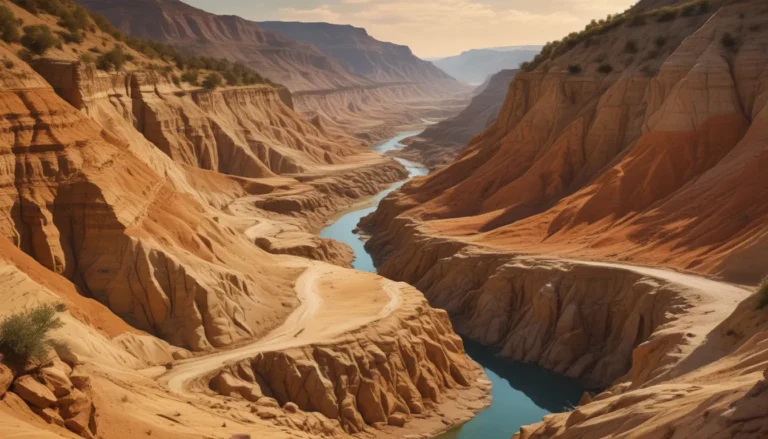A Note About Images: The images used in our articles are for illustration purposes only and may not exactly match the content. They are meant to engage readers, but the text should be relied upon for accurate information.
Have you ever wondered how the continents on Earth came to be in their current positions? The theory of continental drift offers a fascinating explanation for this natural phenomenon. Proposed by Alfred Wegener in 1912, this theory suggests that the Earth’s continents were once united in a supercontinent known as Pangaea and have since drifted apart over millions of years. This groundbreaking concept has revolutionized our understanding of the Earth’s history and continues to provide valuable insights into the dynamic nature of our planet.
Unveiling the Intriguing Facts About Continental Drift
Let’s dive into the realm of continental drift and uncover eight fascinating facts that shed light on this remarkable geological process. From the formation of ancient supercontinents to the ongoing movement of Earth’s tectonic plates, these facts will deepen your knowledge and appreciation of the ever-changing landscapes on our planet.
Fact 1: Alfred Wegener’s Groundbreaking Theory
Alfred Wegener, a German meteorologist, proposed the revolutionary idea of continental drift in 1912. According to Wegener, the Earth’s continents were once interconnected in a supercontinent named Pangaea. This theory laid the foundation for our modern understanding of plate tectonics and the dynamic movement of Earth’s land masses over geological time.
Fact 2: The Birth of Pangaea
Around 200 million years ago, the supercontinent Pangaea began to break apart as a result of plate tectonics. This gradual separation led to the formation of the continents as we recognize them today, along with the emergence of new oceans. The splitting of Pangaea marked the beginning of the continuous drift of Earth’s land masses.
Fact 3: Evidence from Fossils and Rock Formations
One of the compelling pieces of evidence supporting continental drift is the similarity in fossils and rock formations found on opposite sides of the Atlantic Ocean. By studying these matching patterns, scientists have been able to validate the theory of continental drift and demonstrate how the continents were once connected before drifting apart.
Fact 4: Non-Uniform Movement of Continents
Contrary to popular belief, the movement of continents is not a smooth and constant process. At times, continents may move apart, collide, or slide past each other due to interactions between tectonic plates and convection currents within Earth’s mantle. This dynamic movement shapes the Earth’s surface in diverse ways.
Fact 5: Widening of the Atlantic Ocean
The ongoing separation between North America and Europe/Africa is responsible for the widening of the Atlantic Ocean. Although the expansion may seem gradual at a rate of a few centimeters per year, it has significant geological implications over millions of years. This continuous process showcases the transformative power of continental drift.
Fact 6: Technological Advancements in Supporting the Theory
Modern technologies such as GPS and satellite imaging have played a crucial role in validating the theory of continental drift. By accurately measuring and monitoring the movement of continents, scientists have gathered substantial evidence to support this geological phenomenon. These technological advancements have revolutionized our understanding of Earth’s ever-evolving landscapes.
Fact 7: Shaping Earth’s Landscapes through Continental Drift
The movement of continents has not only sculpted the Earth’s landscapes but also influenced the formation of prominent features such as mountain ranges like the Himalayas. The shifting of landmasses has altered climate zones and fostered the development of unique ecosystems worldwide. Continental drift continues to shape the physical geography of our planet.
Fact 8: The Ongoing Evolution of Earth
Continental drift is an ongoing process that unfolds over millions of years, shaping the Earth’s surface and geological features. While the movement of continents may occur at a slow pace imperceptible to human perception, it plays a significant role in the evolution of our planet. Studying continental drift offers insights into Earth’s past, present, and future.
Delving into the Mysteries of Our Dynamic Planet
In conclusion, continental drift remains a captivating concept that underscores the ever-changing nature of Earth’s land masses. By unraveling the mysteries of geological processes such as plate tectonics and land movement, scientists have gained a profound understanding of our planet’s history and ongoing transformations. The interconnectedness of continents, the formation of mountain ranges, and the impact on climate patterns all reflect the intricate dance of Earth’s tectonic plates.
Through the lens of continental drift, we come to appreciate the complex and interconnected systems that drive the geological evolution of our planet. As we continue to explore and study the wonders of continental drift, we unveil new insights into Earth’s dynamic processes and the intricate mechanisms that shape our world.
FAQs: Exploring Common Questions About Continental Drift
- Q: What is continental drift?
-
A: Continental drift is the theory that suggests the Earth’s continents were once united in a supercontinent called Pangaea, which has since broken apart and drifted to their current positions.
-
Q: When was the theory of continental drift proposed?
-
A: The theory of continental drift was first proposed by Alfred Wegener in 1912.
-
Q: What evidence supports the theory of continental drift?
-
A: Evidence supporting continental drift includes matching continental shapes, similar rock formations, fossil discoveries, and the distribution of geological features.
-
Q: How does continental drift contribute to the formation of mountains?
-
A: As continents drift apart, the collision of tectonic plates leads to the formation of mountain ranges through processes such as orogeny.
-
Q: Can continents continue to drift in the future?
-
A: Yes, continents are still in motion today, albeit at a slow rate ranging from a few centimeters to a few inches per year.
-
Q: Does continental drift impact climate change?
-
A: Continental drift plays a role in long-term climate change by influencing ocean currents, which can impact global climate patterns and weather systems.
-
Q: Are there ongoing research or studies related to continental drift?
-
A: Yes, scientists are actively studying continental drift and its effects using advanced technologies like GPS and satellite imaging to enhance their understanding of plate movements.
-
Q: How does continental drift relate to earthquakes and volcanic activity?
- A: The movement of tectonic plates driven by continental drift can lead to the formation of fault lines that trigger earthquakes and contribute to the distribution of volcanic activity along plate boundaries.
Embracing the Marvels of Earth’s Evolution
As we embark on a journey to unravel the secrets of continental drift, we gain a deeper appreciation for the dynamic forces that have shaped our planet over millions of years. The interconnectedness of Earth’s land masses, the formation of geological features, and the ongoing evolution of our landscapes all reflect the transformative power of continental drift. By exploring the wonders of our planet’s geological history, we open doors to new discoveries and insights that enrich our understanding of Earth’s dynamic processes.






